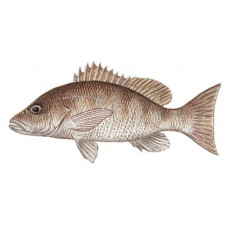Latin name
Lutjanus griseus
Other names
Mangrove snapper; French: sarde grise, vivaneau sarde grise; Portuguese: caranha, castanhola, luciano; Spanish: caballerote, pargo manglero, pargo prieto.
Identification
The body is short, the snout is long and pointed. The front pair of canines on the upper jaw is distinctly larger than on the lower jaw. The soft parts of the dorsal and anal fins are covered with scales at the base, and the anal fin is rounded. The pectoral fins are short (do not reach the vertical through the anus). The coloration of the gray Lucian is variable: from dark gray or dark brown to gray-green. The belly is grayish with olive, bronze, or red hues, sometimes described as having reddish or orange spots running in rows along the underside. A dark horizontal stripe sometimes runs from the lip through the eye, and some fish may have dark vertical stripes or blotches on the sides. The tail may also have a dark edge. Gray snapper can be distinguished from cubera snapper by the shape of the tooth spot in the mouth, which in cubera snapper is triangular and in gray snapper is anchor-shaped.
Distribution
In the western Atlantic common from Massachusetts to Rio de Janeiro, found in the Caribbean Sea, Gulf of Mexico, and Bermuda. Rarely found north of Florida, common off southeast Florida and around the Antilles.
Habitat
Sea-bottom fish of coastal waters. Juveniles are mainly found in the coastal zone on the smooth bottom in places such as estuaries, downstream tidal creeks, mangroves, and seagrass meadows. Adult fish usually live offshore on rough bottoms in places such as coral or rocky reefs, rock outcrops, and shipwrecks, at depths of about 300 feet.
Size
Average weight is only about 1 pound, although inshore catches usually weigh 8 to 10 pounds. Can grow up to 35 inches and 25 pounds, although fish over 15 pounds are rare. The world record in all tackle is considered a 17-pound fish from Florida. Gray snapper can live up to 21 years.
Life history and Behavior
When a gray snapper reaches age 3 or older and is about 9 inches long, it begins spawning, usually at dusk in shallow water during the full moon from June through August. The female is cared for by one or more males, and the fertilized eggs settle to the bottom and remain unattended until they hatch. Gray snapper drift in small flocks.
Food and feeding habits
Zoophageal. Off the coast of the Florida Peninsula, the food composition is dominated by shrimp (62% by volume), followed by fish (23%), crabs (13%), stomatopods (1%) and other crustaceans (1%). Off the coast of the island of Cuba, food composition is more diverse: fish prevail (32% by volume), crustaceans (27%), less eaten annelids (12%). In addition, algae (2%) and mollusks (1%) were found in their stomachs. They feed mainly at night, leaving the reefs at the end of the day and going to the lowlands, where they consume food.
Reproduction
Sexual maturity occurs in the 1st-2nd year of life at a length of 18-20 cm. Off the coast of Cuba, the spawning period lasts from March to October, with peak spawning in June-August. Off the coast of Florida, spawning occurs in June-September. A 32-cm female had a fecundity of 500,000 eggs.
| Classification | |
| Phylum | Chordata |
| Class | Actinopterygii |
| Squad | Perciformes |
| Family | Lutjanidae |
| Genus | Lutjanus |
| Species | L. griseus |
| Features | |
| Conservation status | Least Concern |
| Habitat | Pelagic |
| Life span, years | No information |
| Maximum body weight, kg | 20 |
| Maximum length, cm | 89 |
| Sailing speed, m/s | No information |
| Threat to people | Edible |
| Way of eating | Predator |


